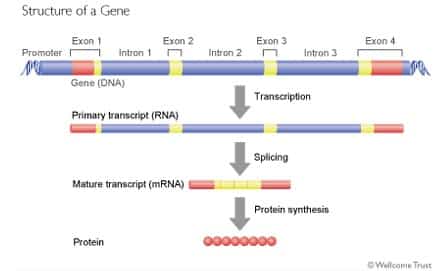The finding of the Introns and the exons was one of the most significant discoveries in genetics in the past fifteen years. split genes were discovered when a lack of relation between DNA sequences were seen during. DNA- mRNA hybridization. For all new mRNA, they must be transcribed by RNA polymerase enzymes.
The transcription begins at the promoter sequence on the DNA and works down, thus the nucleotide sequence of the mRNA is complementary to the one of DNA. In eukaryotes, the mRNA is processed in the nucleus before transport to the cytoplasm for translation. In order for the mRNA to become a true functioning RNA, it must undergo several stages of modification.
At first, when the mRNA is produced, a cap is added enzymatically to the 5¹ end of the RNA by linking a 7-methylguanosine residue by a triphosphate bond this is called the G-cap. The G-cap is necessary for translation.
The subunit of the ribosome recognizes the G-cap and then finds the initiation codon to start the translation. As the mRNA comes finishes transcription, the Poly A tail is added to the 3¹ end. As the two ends are placed the mRNA becomes pre-mRNA.
The pre-mRNA consists of splicing and non-coding regions. pre-mRNA molecules are much longer than the mRNA molecule needed to code for its protein. The regions that do not code for amino acids; aa, are scattered all along the coding region. The genes are split with coding regions, called exons, short for expressed regions; in between the exons the non-coding region called introns exist. Before the translation of mRNA the introns must be spliced off.
Splicing is a complicated process for the cell. It must locate every intron in the primary transcript. An average mRNA consists of eight to ten introns, some even contain sixteen introns. exons, like introns, are also spread apart. Some of their codons may be split by introns, so information for a single amino acid could be some distance apart. Splicing takes place in the nucleus but also could take place in the cytoplasm and the mitochondria. After the splicing of the introns, the G-caps and the Poly A tails remain on the mRNA.
A single gene can code for multiple proteins by alternative splicing. A single strand was found to be coding for twenty different proteins, depending on how the exons are assembled. Different splicing combinations are regulated in a tissue-specific manner.
Most of the transcribed DNA are introns. ninety-nine percent of the information contained in the gene transcript is destroyed when the introns are eliminated since exons are only translated. Most genes have introns. Only a hand full of organisms is found without introns. Larger eukaryotes tend to have bigger and more numerous amounts of introns compared to smaller eukaryotes.
There are a sequence of nucleic acids at the exon-intron junction of mRNA allowing intron splicing., From what is known there is a GU at the 5¹ splice site and AG at the 3¹ splice site for most genes.
This is called the GU-AG rule Splicing enzymes recognize these sites with the help of ribonucleoprotein called snRNP or snurps. snurps are formed by small nuclear RNA fragments of less than three hundred nucleotides called snRNAs. As an RNA molecule is being transcribed, four snurps attach to it combining into a large spliceosome. The abundant snRNAs catalyze the cutting and the splicing of the gene.
In a self splitting intron, the hairpin structure brings the ends o the introns near to the branch point. Then the introns themselves catalyze the making of the loop joining the two exons. The difference between self-splicing intron and one which requires the spliceosome is that the non-self splicing introns can split any introns, almost any size.
This helps the organism to survive mutations. When a mutation forms, sometimes the self-splicing introns lose their hairpin structure not allowing themselves to be spliced off.

